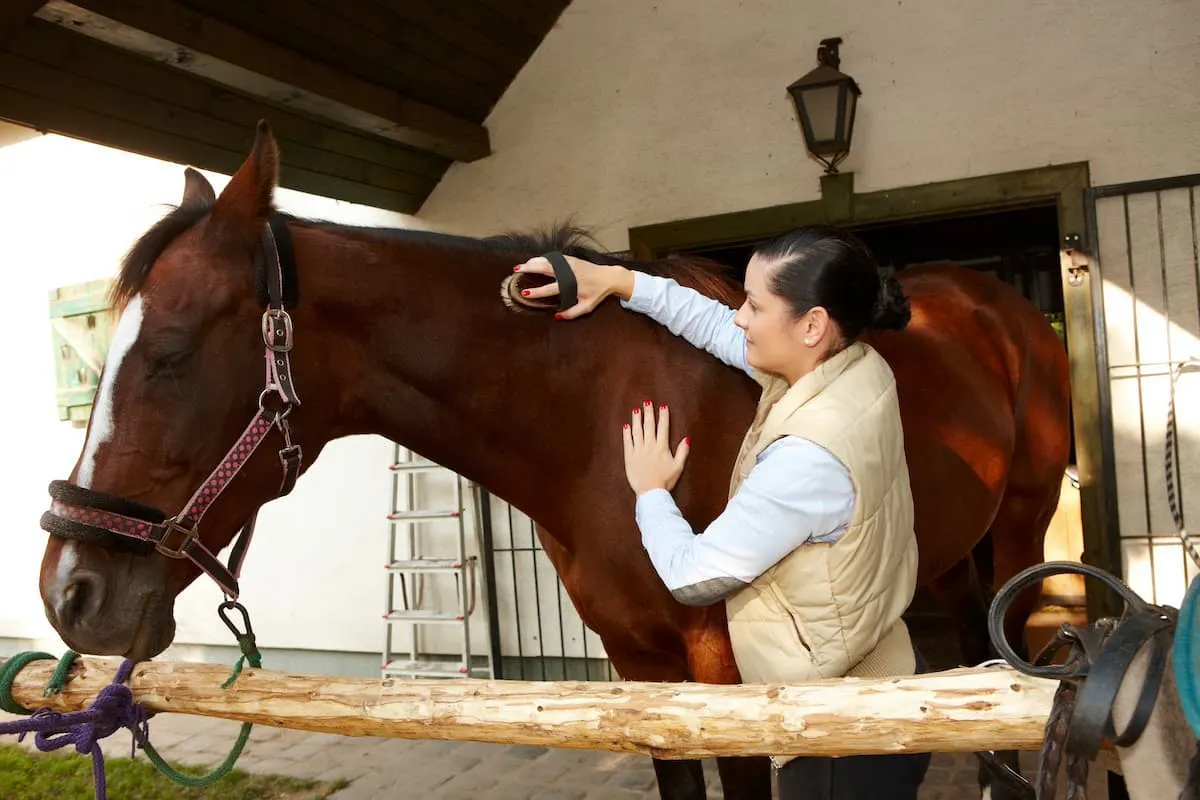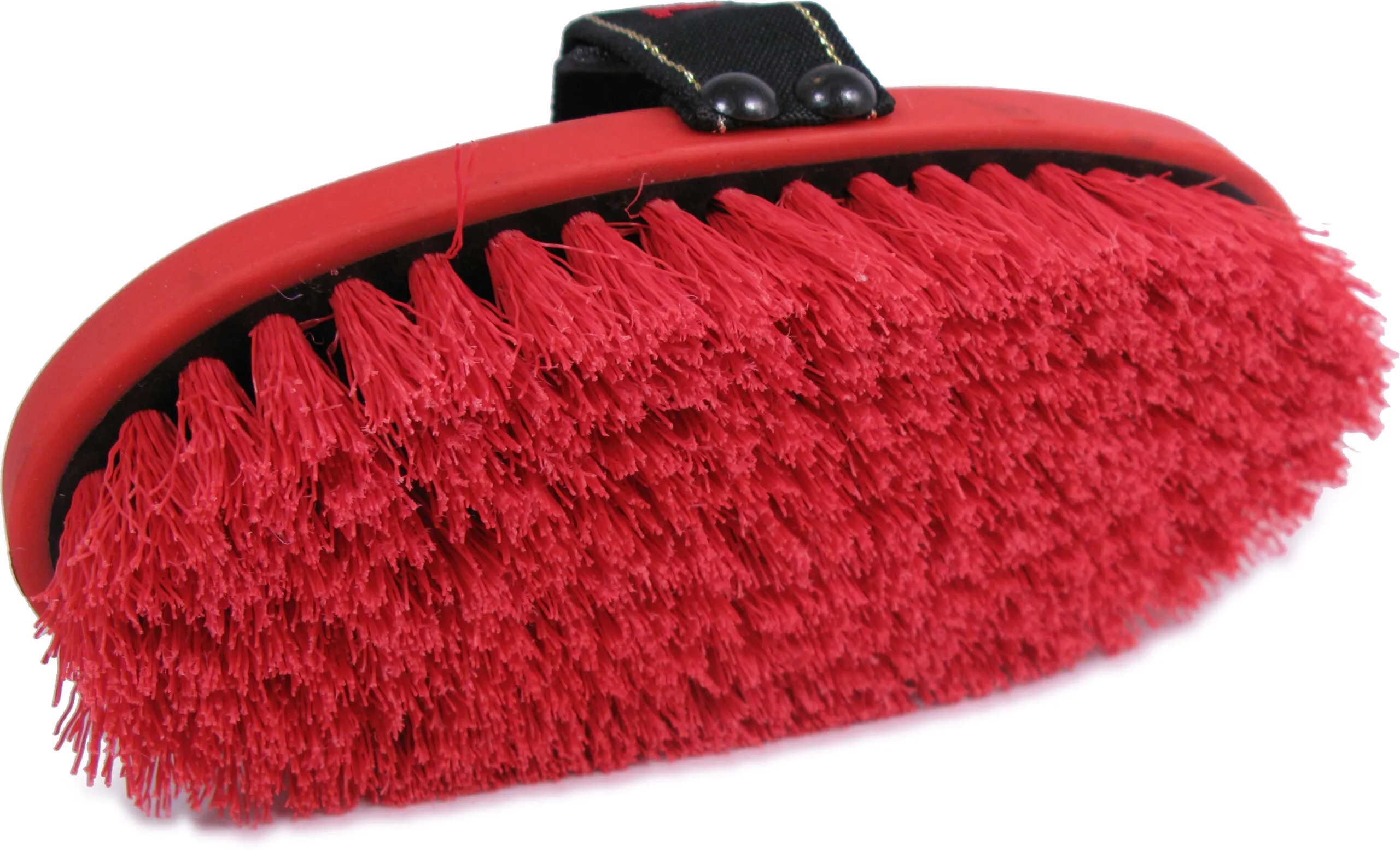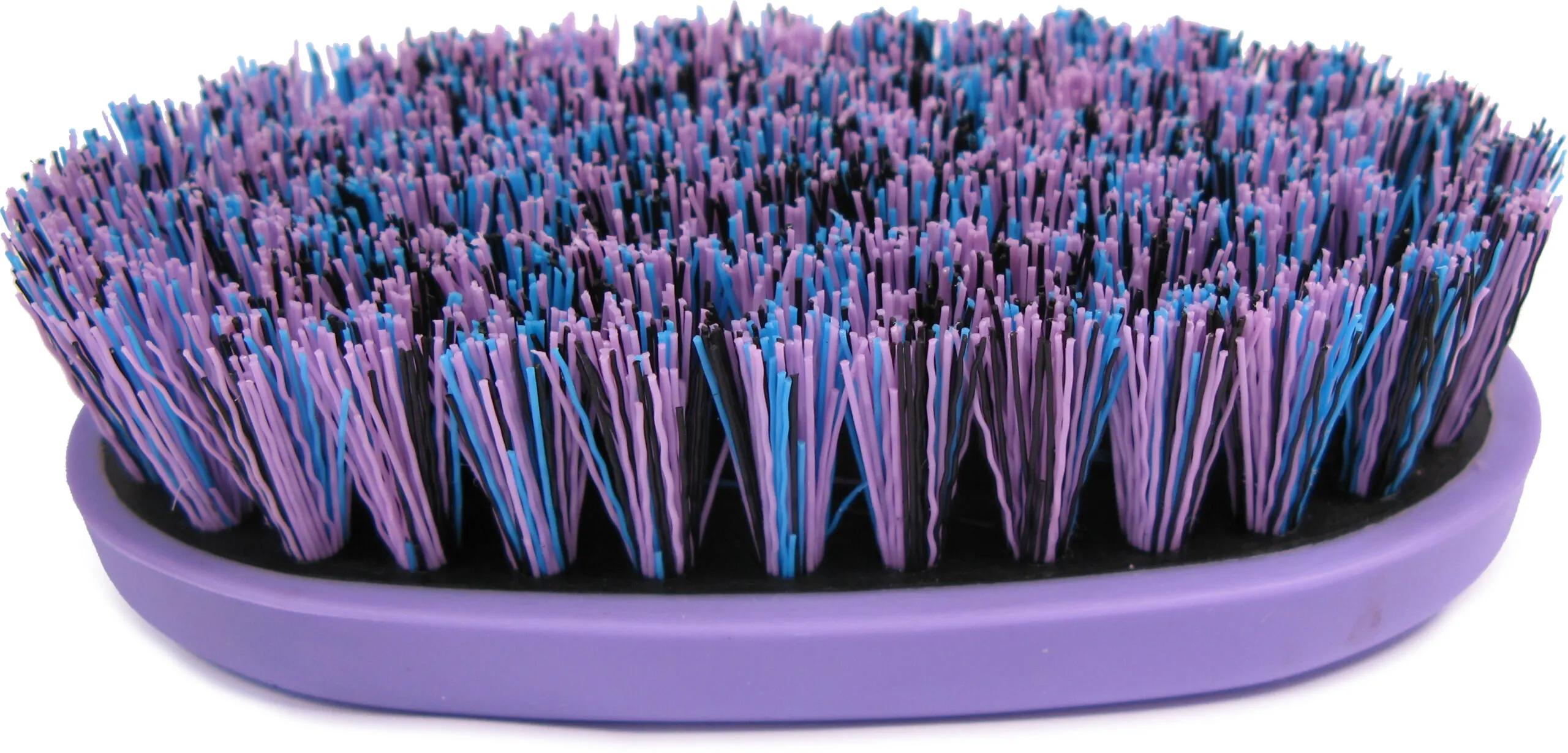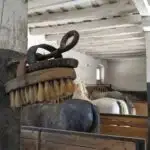Grooming has many benefits for horses – and even for humans since grooming horses can help promote a bond between horses and humans. Good grooming can only be done if your grooming tools are effective.
When we go too long between cleaning horse brushes, their effectiveness is reduced. Why? Well, when we brush horses’ coats, we are exposing the horse brush to dust, loose hairs, sweat/sweat residue, and body oils. As we remove these things from horses’ coats using the brushes, there is often a buildup of dirt and hair in our horse grooming brushes – all held in place by a nasty buildup of body oils and sweat residue!

Just like maintaining good hygiene for humans requires a clean washcloth or scrubber to make sure that baths and showers actually get our bodies clean, the same is true for horse brushes. Good horse grooming is good for horse’s bodies and minds (source), but horse brushes that are caked with sweat, oil, and dirt aren’t just unhygienic.
How often you should clean your horse brush will vary depending on how often you groom your horse and how dirty your horse gets between grooming. In any case, you should clean your horse brushes a minimum of once a year (and for most of us, 2 to 3 times a year). If you do an annual spring cleaning in your barn, include horse brushes in your cleaning routine, around the same time that you wash your horse blankets each spring.
A step-by-step guide to cleaning horse brushes

A step-by-step guide to cleaning horse brushes
Total Time: 15 minutes
Use a curry comb to remove visible dirt and hair from your brush’s bristles
First use your fingers to peel off any clumps of hair on the brush, then scrape your brush across the surface of a curry comb repeatedly to disturb the fibers, knock out excess dirt, and scrape loose horsehair from the brush fibers.
Shake to dislodge dirt
Smack the brush- bristle side down – on a hard surface. Getting rid of as much dust as possible before using water to clean, in the following step, helps this cleaning method to be more efficient and effective at deep cleaning your horse brushes.
Wash and/or soak
Mix a bucket of warm water with a tablespoon of shampoo (horse or human shampoo both work equally well to break up the type of oils that have transferred from your horse’s coat onto the brush). Synthetic fiber brushes with synthetic (i.e. plastic) handles can be dropped in the bucket to soak, while natural fiber brushes or brushes with wood or leather handles should only be dipped in the water.
Scrub the face of two brushes together and use the agitation from each brush to clean the other. Soap in the water will surround dirt molecules and make them easy to wash away. Dump your water, refill with clean water, and rinse your brushes a few times using this same method. For washing very dirty synthetic-bristle brushes, Dawn dish soap can boost oil-dissolving cleaning.
Dry brushes completely
When water runs clean from your horse brushes’ rinse water, it’s time to dry your brushes. Place your brushes on a towel, newspaper, or other absorbent surface handle up (bristles down), and allow brushes to sit until dry. To speed the drying process, place the brushes in bright sunlight or place them near a fan or dehumidifier.
Supply:
- Warm water
- soap or shampoo

How to Clean Horsehair Brushes
Natural fiber brushes are ideal for grooming horses. Brushes made from boar hair or horsehair make outstanding brushes that lift dust off the horses’ coat and bring natural oils to the surface of the coat, creating a natural sheen that glows in the show ring. Horsehair, boar hair, and even goat hair horse brushes are more delicate than synthetic brushes and should be cleaned with more care than plastic brushes.
To clean horse brushes with natural fibers, skip the soak and use as little water as possible. Instead, clean natural fiber horse brushes with the following method
- Spend a little bit longer knocking out the dust and combing out the fibers.
- Next, mix a shallow pan of warm water with vinegar added.
- Dip the tips of the bristles in the water
- Blot or gently rub the dampened bristles on an old towel to transfer dirt from the brush to the towel.
- Repeat steps 3 and 4 until the bristles stop transferring dirt onto the towel.
- Dry handle-side up on a sheet of paper or newsprint.
If your brush is very dirty, you may need to dump and refill your rinse water one or more times during the process
How to clean wooden horse brushes
Our how-to clean horse brushes guide is a safe method for cleaning wood horse brushes. The main difference between cleaning a plastic-backed horse brush and a horse brush with a wood handle is that brushes with wood handles should not be soaked for an extended period, and after soaking they should be thoroughly and completely dried. Allowing a wood handle horse brush to soak for too long in water causes the fibers of the wood to swell. Swollen wood handles can cause a horse brush to crack, split, or start splintering.
After cleaning, if your horse brush does not have a protective finish (like polyurethane), you’ll want to oil the back of your horse brush with linseed oil to keep the brush’s wood handle from drying out and becoming a source of splinters.
How to deep clean used horse brushes
Good horse brushes can be expensive, and while purchasing used horse brushes can result in big cost savings, used grooming supplies can potentially be a way to expose our horses to parasites, bacteria, or even skin fungus.
Just like how to clean dirty makeup brushes, cleaning horse brushes involves removing visible debris and the bacteria that might be in the brustles. If you’re trying to deep clean horse brushes so they can be switched from horse to horse or barn to barn, you’ll need to do a deeper clean than described here.
Before switching brushes between horses, do a deep clean that modifies these cleaning instructions to add bleach to your soak water. Brushes that are deeply cleaned using these instructions and that have been soaked briefly in bleach should be safe to use for a new horse without exposing your horse to the potential bacteria, fungus, or parasites of the last horse that the brushes were used on.
How to disinfect horse hair brushes
Expensive horsehair, boar hair, and leather-backed grooming brushes can be difficult to disinfect. For deep cleaning these natural fiber brushes, we recommend using hydrogen peroxide in a spray bottle. Spray the bristles until they damp- all the way down to the base of the bristles (you may need to spread bristles apart as you spray the hydrogen peroxide on the grooming brush to ensure full coverage). Hydrogen peroxide will neutralize bacteria and pathogens on the surface of the brush, and in just a few minutes it will break down into its basic components: simple oxygen and water.
Even though this disinfecting method for horse brushes does get the natural fibers very wet, it spares them from the extreme soaking and drying of cleaning with large amounts of water and from the harsh effects of bleach or other disinfectants. After a horse brush has been cleaned with hydrogen peroxide, dry the brush with the method described in our how-to: bristles down on an absorbent surface and a well-ventilated area.

FAQ’s
What should I clean horse brushes with?
Water and gentle soap are the best things to clean horse brush with, however, you’ll also likely need other brushes (to comb out excess hair) and a bucket to soak brushes and break up oil and scum deep in the brush. Horse shampoo, human shampoo, Dawn dish soap, and even vinegar can effectively clean horse brushes. For disinfecting horse brushes, use bleach, rubbing alcohol, Listerine, or hydrogen peroxide.
Can you put horse brushes in the washing machine?
It’s generally a very bad idea to put horse brushes in a washing machine- although, if we’re being completely honest, it’s not an absolute “no.” Top load washing machines with the option to run a cycle with delicate agitation and no spin might be able to wash horse brushes without causing damage to the brushes or the washing machine (or both). However, the brushes should be pre-cleaned to avoid clogging the washing machine and the brushes should be placed inside of a heavy-duty lingerie bag for protection. We do not advise cleaning horse brushes in a washing machine.

